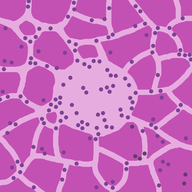Porous Scaffolds for 3D Culture to Improve Differentiation of Pluripotent Stem Cells to Beta-Cells
TECHNOLOGY NUMBER: 2018-428

OVERVIEW
Improved in vitro differentiation of human pluripotent stem cells (hPS) into functional Beta-cells- A microporous polymer scaffold that facilitates generation of 3-D islet-like structures
- Creates structures that are clinically transferrable into anatomic sites such as peritoneal fat
BACKGROUND
Insulin dependent diabetes mellitus is a chronic disease that affects nearly 20 million people worldwide. True type 1 diabetes (T1D) is caused by the destruction of insulin-producing pancreatic Beta-cells, leaving patients unable to regulate their blood glucose levels. T1D typically commonly manifests during childhood and leaves those who are afflicted reliant on insulin pumps or daily injections for the duration of their lives. These patients face demanding lifestyle changes include consistent blood sugar monitoring, real-time insulin dose adjustments based upon the results, and consideration of the effects of factors such as food intake, mood, and physical activity on blood sugar levels.
Ongoing research efforts have involved transplantation of pancreatic tissues from cadavers, though this approach may be hindered by the need for repeated infusions, a limited supply of donor tissue, and the requirement for long-term immunosuppression to prevent rejection. Stem cell-derived pancreatic Beta-cells represent a replenishable source of insulin-producing tissue that may circumvent the shortage of donor tissue, though limitations of this strategy have included a low efficiency and consistency of Beta-cell maturation as well as a need to transplant at non-clinically anatomic sites to achieve optimal differentiation. As such, a need exists for improved culture and transplantation methods to bring Beta cell technology to T1D patients.
INNOVATION
Researchers have invented a method for improved differentiation of human pluripotent stem cells (hPS) into functional Beta-cells through an approach that creates a specialized microporous polymer scaffold that has been optimized to promote efficient Beta-cell maturation. The scaffolds are comprised of microporous polymers (250-450uM) with a structure and pore size that promotes a high insulin yield. Additionally, the scaffolds can be coated with extracellular matrix (ECM) components which mimic the in vivo pancreatic environment. Cells are seeded onto the scaffold and cultured in vitro for weeks to initiate the differentiation process towards a Beta-cell lineage. The architecture of the scaffold protects the cells and facilitates the generation of a 3D islet-like structures. The Beta-cells produce insulin in response to a glucose challenge, thereby demonstrating that they are functional. The islet-like structures can be transplanted into clinically translatable sites such as the peritoneal fat to restore insulin production and reverse insulin dependent diabetes mellitus. Moving forward, in vivo studies using animal models can be carried out to assess Beta-cell survival, insulin production, and the ability to be triggered by glucose blood levels.